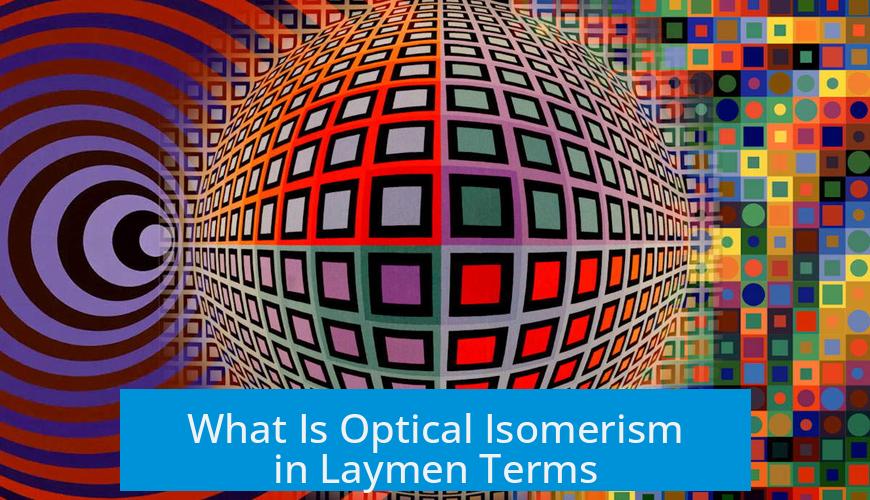What Is Optical Isomerism in Laymen Terms?

Optical isomerism occurs when two molecules are mirror images of each other but cannot be superimposed, much like left and right hands. These molecules twist plane-polarized light in opposite directions, displaying optical activity. This effect arises due to a special arrangement of atoms around a central carbon atom bonded to different groups.
Understanding Optical Isomerism Through Everyday Objects
Imagine your left and right hands. They look alike and have the same parts—fingers, thumb, palm—but you can’t place one perfectly on top of the other to align every finger. This is because they are mirror images but not identical in orientation. This property is called “non-superimposability.” Optical isomers behave similarly.
Two molecules might have the exact atoms connected in the same order. Yet, they exist as two forms that look like mirror reflections but cannot overlap perfectly. Chemists call these pairs “optical isomers” or “enantiomers.”
Why Hands Help Explain Optical Isomerism
Hands provide a simple analogy:
- Left and right hands are mirror images.
- They have the same parts in the same sequence.
- They cannot be placed exactly on top of each other.
- One is not a superimposable copy of the other.
This explains why optical isomers differ. They share the same atoms and bonds but differ in spatial arrangement, leading to unique properties.
Optical Activity: Effect on Plane-Polarized Light
One key property of optical isomers is how they interact with plane-polarized light. Polarized light vibrates in a single plane. When passed through a solution containing one optical isomer, the light’s plane rotates either clockwise or counterclockwise.
This rotation happens because the three-dimensional arrangement of atoms twists light differently depending on the isomer:
- One optical isomer rotates polarized light clockwise (dextrorotatory).
- The mirror image rotates it counterclockwise (levorotatory).
If a solution contains equal amounts of both isomers—a racemic mixture—the rotations cancel out. Hence, no rotation of light is detected.
Visualizing with Molecular Models
Consider a carbon atom bonded to four different atoms or groups, such as hydrogen (H), fluorine (F), chlorine (Cl), and bromine (Br). This tetrahedral carbon center creates the perfect scenario for optical isomerism.
You can arrange these four groups in various ways around the carbon. Then, imagine building a mirror version of that molecule. The original and mirror molecule will not be superimposable despite having identical formulae. Each is a unique optical isomer.
Simple Explanation at the Molecular Level
Each optical isomer has atoms connected in the same order. However, the spatial orientation, or how these atoms “bend” around the central carbon, differs. This small difference changes how the molecule interacts with polarized light and other chiral molecules.
These orientation differences lead the molecule to display unique chemical behavior and biological activity, especially in living organisms where “handedness” of molecules matters greatly.
How Optical Isomerism Affects Chemistry and Biology
The presence of optical isomers matters greatly in various chemical and biological contexts:
- Enzymes often recognize only one optical isomer of a molecule, affecting biochemical reactions.
- Pharmaceuticals may have one effective isomer and one inactive or harmful one.
- Synthesis of organic compounds often requires separation or selective production of one isomer.
Thus, understanding optical isomerism helps predict molecule behavior, drug design, and material properties.
Common Challenges in Learning Optical Isomerism
Optical isomerism can be confusing. It involves vocabulary like chirality, enantiomers, racemates, and optical activity. The key difficulty is grasping three-dimensional spatial ideas from two-dimensional drawings.
Here are some tips that help:
- Use physical model kits to build molecules and their mirror images.
- Visualize hands and everyday analogies to understand non-superimposability.
- Watch educational videos to see molecules rotate and interact.
- Practice problems that involve recognizing chiral centers and drawing isomers.
Summary of Key Concepts
- Optical isomers are non-superimposable mirror image molecules.
- They differ in spatial arrangement around a central atom, typically carbon.
- They rotate plane-polarized light in opposite directions.
- A racemic mixture contains equal amounts of both isomers, cancelling optical activity.
- Understanding these differences is essential in chemistry, especially organic and pharmaceutical chemistry.
Final Notes
Though it may seem challenging at first, mastering optical isomerism becomes easier with practice and visualization. Real models and analogies like hands greatly improve comprehension. This concept bridges basic chemistry and advanced molecular behavior, making it fundamental in scientific studies.
What does optical isomerism mean in simple terms?
Optical isomers are molecules that are mirror images but cannot be placed on top of each other exactly. Think about your left and right hands—similar but not identical when you try to match them.
How do optical isomers affect light?
These molecules can rotate polarized light. One type twists the light clockwise, while its mirror image twists it counterclockwise. A mix of both cancels out the effect.
Why can’t optical isomers be superimposed?
The atoms are arranged so that their mirror images do not line up exactly. No matter how you rotate them, they remain different, like left and right hands.
Can you give a simple example of optical isomerism?
Imagine a carbon atom bonded to four different atoms. Making a mirror image of this setup creates two versions that can’t be aligned perfectly, showing optical isomerism.
Why is understanding optical isomerism important?
Because these molecules behave differently in biological systems and experiments. They can affect how drugs work or how chemicals react, making their study crucial.





Leave a Comment